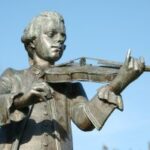During both the Baroque and Classical eras, music was being written in a lot of the same genres (opera, oratorio, concerti, sonati, and so on), but the baroque sonata da chiesa (church sonata) was replaced by the solo sonata. Most sonatas were written for keyboard, but some were written for other instruments. The trio sonata, a sonata written for a trio over a very heavy bass line with harmonic filler provided by a harpsichord, continued to exist into the Classical era, but eventually evolved into true trios. Operas, oratorio, and cantatas were still being written. The concerto evolved from a concertino and concerto grosso to simply being a solo concerto. The symphony as a genre was evolving out of the opera overture.
During the Pre-Classical era, musical forms were altered, perfected, and invented. Most art songs were strophic, but in arias, the da capo aria was the most common. Most Preclassic composers used binary form for the instrumental music, but that pattern became modified and expanded into sonata form. Cadence rhyme became more common.
There were three styles of writing Preclassical music: style galant, empfindsamer stil, and sturm und drang. In the style galant, most music was monophonic, generally in the form of melody with accompaniment, although some polyphonic music was written. Major keys were preferred, and the harmony became simpler and slower. Figured bass was still used, but the bass line became a support to the melody. To prevent boredom with a slower harmonic rhythm, murky and alberti bass patterns were used. Style galant music was highly ornamented, but did not have the grandeur of Baroque music.
Empfindsamer stil (the sensitive style) gave music more expression. The Baroque doctrine of affections evolved into the conviction that there should be a continual change of expression throughout the piece, along with appropriate dynamic shadings. C.P.E. Bach claimed that instrumental melodies should be made according to the model of good vocal melodies. This style was not as heavily ornamented as style galant or the Baroque era, in order that tone could shine through. Often, the music would be melody with a light accompaniment.
Sturm und drang started out as a movement in German literature with the artistic aim of being as emotional as possible. The adherents of this movement believed in personal freedom, particularly from conventions that restrained creativity. This movement sowed the seeds of German Romanticism, particularly in opera. The closing of Mozart’s Don Giovanni is an example of this style.
The preclassical era did not entirely supplant the Baroque; instead, they existed alongside each other. In some ways, however, the preclassical period was a reaction to Baroque grandeur and ornamentation. Eventually the Baroque styles fell into disuse, and truly Classical styles claimed all of music, but composers throughout the centuries still looked to the works of Bach and other Baroque composers to learn how to write.
Source: The Development of Western Music by K. Marie Stolba




